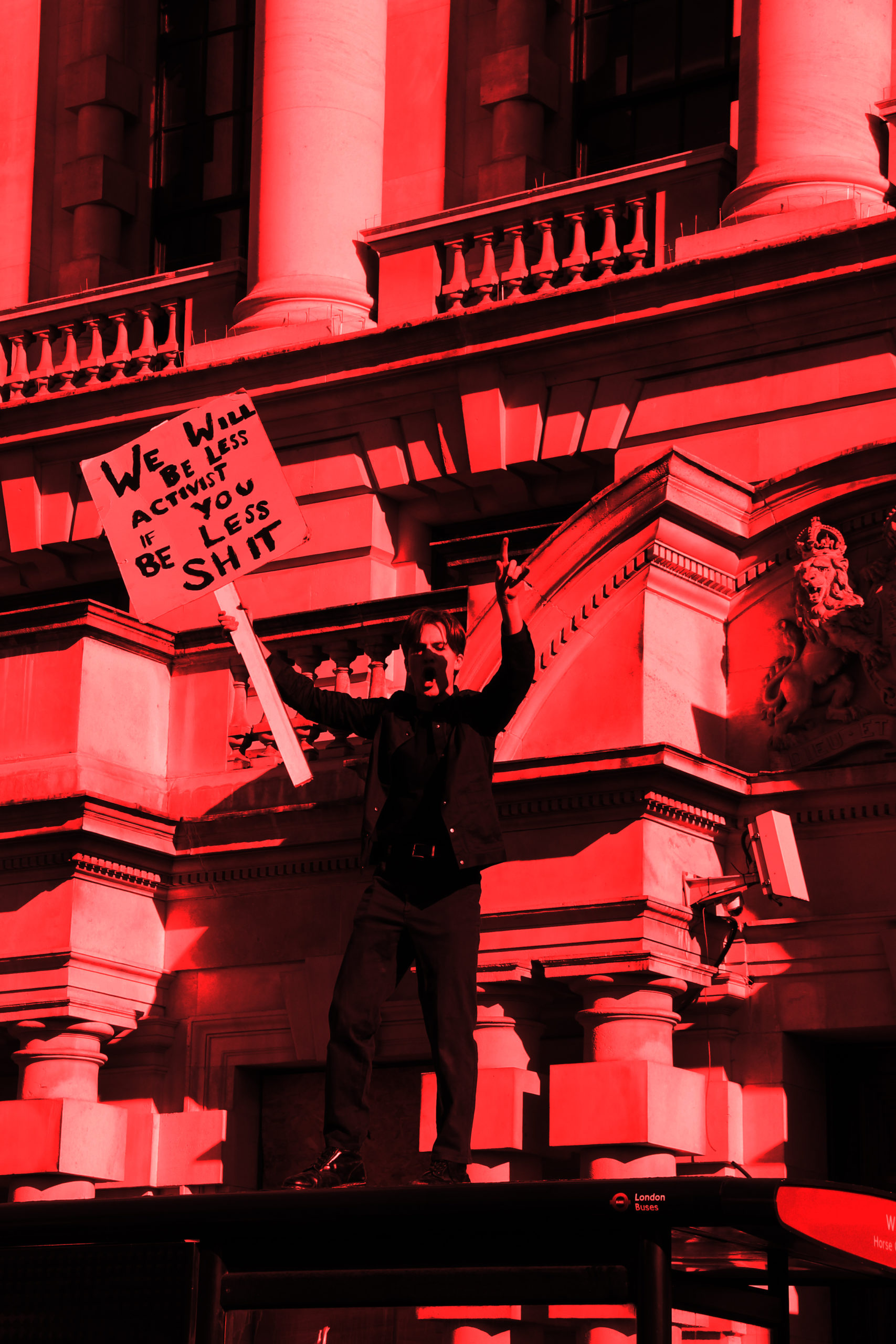Photograph: Amber Charlton (She/Her)
Words: Leyona Bray Kaji (She/Her)
As a passionate activist, I’m often surrounded by those who feel extreme anger towards institutions and oppressors that continue to create and inflict severe pain. I, too, feel rage towards those responsible for denying basic rights whilst destroying the planet, but I do not believe spreading anger is the solution. I want to see widespread concern about these issues, individual behavioural change, and mass civic engagement. I don’t want to see red. Not out of ignorance but because I’m unsure whether anger is actually effective.
Within activism, we are often fuelled to express anger, rebel and retaliate against the injustices we face. We are told to feel this rage, to ‘see red’, to shout as loud as we can until we feel our blood pumping through our tense bodies. Often there is a sense that people aren’t angry enough: more should be felt, and more should be done. This idealises the expression of anger, especially within subcultures and activist groups that forcefully reject mainstream government and culture. Given the current state of affairs, there is so much to be angry about: the climate, energy and cost of living crises, as well as the continued mistreatment of marginalised groups by our institutionalised and ineffective government. I am not looking to tell people who are (rightly) angry to stop spreading anger in the world. However, is spreading anger the answer to fighting these injustices?
The Cambridge Dictionary defines anger as ‘a strong feeling that makes you want to hurt someone or be unpleasant because of something unfair or unkind that has happened’. The glorification of intense and destructive emotions is somewhat absurd, considering it seems to contradict what most activists fight for: world peace and systemic change. Anger is a natural emotion that arises uncontrollably in response to feeling threatened, disrespected, and powerless. Emotional expression is undeniably vital, but it may not be beneficial to spur these feelings on. It disperses movements’ focus onto fighting and blaming the aggressor, meaning attention and energy becomes diverted away from developing solutions. This prevents people from focusing solely on initiatives such as individual action, creating awareness, lobbying, boycotting, and protesting.
Definitions are contested as some argue that the term does not include the desire to inflict harm on the perceived aggressor. Feeling strongly and passionately about something doesn’t mean you have to be in a physical state of anger, and often I don’t think this state is reached solely through this emotion. We can still protest, give speeches, and boycott passionately without being in this physical state of anger and aggression. It is physiologically not healthy to frequently be in this state. Anger has been linked to many health risks, including high blood pressure, coronary heart disease and diabetes. Promoting this physical anger can be harmful and won’t change the actual situation of the issue, just our perception.
Mass media often highlights and exaggerates anger demonstrated by protestors, focusing on the more irrational and violent acts within protests, such as the aggressive portrayal of the Black Lives Matter movement in America. Although there may be an exaggeration of the forceful and angry tactics used, many activists also believe that anger, which leads to aggression and forceful action, is required to create urgency and highlight the extremity of the issues.
Perpetuating the image of the hate-and-anger-filled activist can often be ineffective as it reduces legitimacy, undermining the positive effects of a social movement. Often in the state of politics, which is greatly influenced by the media, the loudest voices always seem to win. Anger can also intimidate and alienate those on the fence of uncertainty to remove themselves from the argument. Anger begets anger from the opposition, which can cause hyperpolarisation and extremism, ultimately inhibiting social change. Spreading constant anger within activism may also increase feelings of anger in other aspects of life outside of politics. Most of us understand the problems of anger within interpersonal relationships. It is an undesirable, destructive, and persistent emotion.
Buddhism and Stoicism similarly believe that anger is the stem of our problems and is never beneficial. The Dalai Lama claims: ‘Too much emotion, attachment, anger, or fear [means] you can’t investigate objectively’. It follows that ‘seeing red’ warps our sense of reality and our minds become clouded with rage. People must have inner peace to promote world peace.
Nevertheless, rage and fury held about an issue will increase your motivation to act and will, in turn, promote the desire to spread anger. In this way, anger emotively drives people to create social change. Without anger, we would not care enough about anything. However, studies show anger can compromise decision-making and cognitive function, presenting its inefficiency in activism because of its hindering nature. Compassion can equally create the motivation required for change and concern. In the case of the climate crisis, consideration and empathy for future generations and communities at immediate risk from the threats posed by climate change can also provide the determination for action.
I understand my bias and privilege as a white-passing woman in higher education living in the UK. I am not oppressed or impacted nearly as extensively as others which will influence my view on the efficacy of anger in activism. I don’t think we should or can eradicate feelings of anger for such significant issues, considering the temporary arousal of anger is uncontrollable. Yet, we can control how we express ourselves and react, individually and societally, to provide calmer spaces to reflect and develop solutions in a more united way with clarity. We also have control to stop spreading and forcing this emotion onto others. Anger, fear and guilt will create a loud, forceful stir in the media but using rationale, clarity and compassion, I believe, is more effective.
We don’t have to see red. What will you choose?

